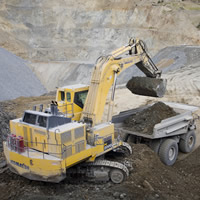Canada’s mining industry strong, but there are challenges ahead

Canada’s mining industry must stay competitive to benefit both Quebec and Canada at large, stressed Pierre Gratton, president of the Mining Associat
Canada’s mining industry must stay competitive to benefit both Quebec and Canada at large, stressed Pierre Gratton, president of the Mining Association of Canada, in a keynote address to the Montreal Council on Foreign Relations.
“Canada is currently a global mining powerhouse and its economic contributions reach far beyond the mine gate and the communities where we operate by providing high-paying jobs and spinoff business opportunities across the country,” said Gratton. “However, our current leadership status should not be taken for granted as mining investment dollars are highly mobile and global competition for it is fierce.”
As the third largest mining region in Canada, Quebec has been an important part of this growth, but the province has recently lost ground in relative terms.
Gratton noted that Quebec doubled the value of its mineral production over the past decade, but other provinces like BC, Saskatchewan and Newfoundland and Labrador have tripled, quadrupled and even sextupled the value of mineral production over the same period.
“I am concerned that mining growth in Quebec may fall off significantly due to the present policy direction of the government,” said Gratton in relation to the expected tabling of new mining tax legislation by the Quebec government that could see high royalties and taxes placed on mining companies operating in the province. “Quebec should be aiming to maintain its status as a sophisticated mining jurisdiction, one that understands that tax instability and higher
royalties will drive away investment, economic development and employment.”
Canada is one of the largest mining countries in the world. The Toronto Stock Exchange (TSX) and the TSX Venture Exchange are home to 58% of the world’s public mining companies. Canada is a top five producer of uranium, potash, nickel, platinum, aluminum, diamonds, zinc and steel-making coal. Moreover, its reputation for being rich in resources led to Canada landing the top spot for attracting world exploration spending in 2011 at 18 per cent.
Canada’s mineral production in the last two years surged to new heights. In 2011, mineral production value reached a record $50.3 billion. It declined in 2012 to $46.9 billion due to some softening in the commodity market, but this figure essentially represents a return to the previous peak set in 2008.
From a Canada-wide perspective, a largely positive outlook for mineral and metal prices over the long term supported by China and other emerging markets underscores the opportunities before Canada. However, for Canada to be able to seize these opportunities, it must remain competitive.
Gratton suggests Canada’s mining sector must maintain its competitiveness by:
- Maintaining low inflation, reducing debts, and preserving and improving competitive tax levels.
- Staying the course as a free trader and proactively engaging the emerging markets, especially China.
- Improving the regulatory framework for mining projects, while keeping environmental protection a top priority.
- Addressing the looming skills crisis in the mining sector, which is estimated at requiring 145,000 new workers over the next decade to replace retirees and fill new positions.
- Investing in critical infrastructure to support new mining projects, including key transportation needs such as ports, all-weather roads and rail.
Staying the course as a free trader and proactively engaging the emerging markets, especially China.
Addressing the looming skills crisis in the mining sector, which is estimated at requiring 145,000 new workers over the next decade to replace retirees and fill new positions.
“To maintain our leadership, we also have to remain leaders in responsible mining and act in a way that Canadians have confidence in. If we keep doing things right with our wealth of resources, Canadians will continue to thrive through the development and production of new mines here in Canada, the continued growth of our industry abroad, and the numerous spinoff economic and social benefits that flow from both,” said Gratton.
Source: Canadian Manufacturing newsletter




